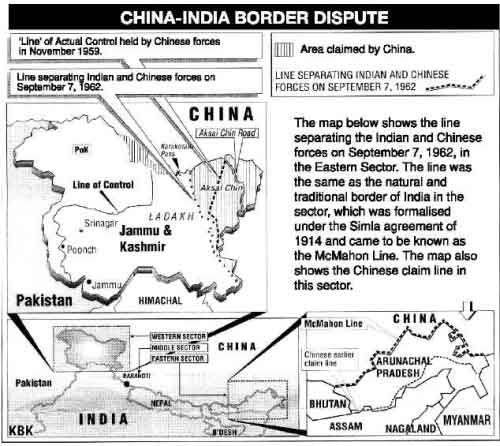Co-Written by Abhay Jain and Sandeep Pandey

Unable to resolve its border disputes with Pakistan and China, India has now managed to create a dispute with Nepal in the process of building a road to Kailash Mansarovar in Tibet through areas which are claimed by Nepal. History has taught us that such disputes will require disproportionate attention and resources and will remain a bone of contention over long period, sometimes erupting in wars costing immense human suffering and lives, keeping our relationship with neighbours if not bitter, at least not such that we can trust each other. Why can the Prime Minister who wanted this road built to cater to his Hindu constituency not talk to Nepal, with whom India shares its majority religion, to have a joint management of the disputed area, something which may be more difficult to arrive at with Pakistan or China because of the complexity and history of problems involved?
Time has come to revisit a largely abandoned theory of boundary dispute resolution: The Condominium. A condominium in international law exists when two or more States exercise joint sovereignty over a territory. More specifically, a condominium exists when “two or more states together exercise joint sovereignty on the same territory, and such sovereignties mutually limit their activities, at least in principle, on the grounds of legal equality.”
Condominium has been burdened historically, by the primacy of sovereignty as a consideration in the state system at the cost of peace and loss of lives. Other resolution devices rely upon indivisible notions of sovereignty, which means that, regardless of whether a dispute is resolved peacefully or through armed conflict, one side invariably loses on a claim it believed to be valid. This resolution is often temporary as the losing side never completely abandons its claim and seizes every opportunity to recapture it. If we look closely, we find that there is nothing in the nature of sovereignty to render impossible a permanent and agreed division of sovereignty as suggested by the very nature of a condominium.
A Framework Agreement was signed on 3 August, 2015 by the Narendra Modi government with National Socialist Council of Nagaland (Isak-Muivah) in which a concept of shared sovereignty and inclusive relationship of enduring peaceful co-existence of the two entities has been agreed to, alluding to government’s willingness to accept a flexible nature of sovereignty with an objective to resolving a long standing dispute with Naga people.
Today, the European Union is taken for granted – an institution with its own legislature, its own courts, and even its own currency. The fact that European States, the paramount forces in the creation of sovereignty in the Westphalian order, have increasingly ceded authority to a non-state entity shows that States are re-evaluating their traditional notions of sovereignty.The willingness of States to cede sovereignty to other bodies suggests that condominium could, at last, serve as a viable long-term mechanism to resolve boundary disputes.
The nineteenth and early twentieth centuries would witness a proliferation of condominiums on the international stage, as resource hungry and land-hungry European colonial powers were often pitted against one another over a disputed territory. One prominent example of such a modus vivendi is that of a small swath of territory on borders of Netherlands, France and Belgium known as Neutral Moresnet, where a condominium was successfully implemented, from 1816 until 1919 by Prussia and the Netherlands. After the treaty of Vienna failed to expressly articulate who held the district of Moresnet, both the Netherlands and Prussia held competing interpretations of the treaty favouring their own claim to the land. In 1816 the dispute was resolved in the Treaty of Aix-la-Chappelle, an accord that established the framework of condominium rule over the disputed territory. The treaty created a governmental structure where legislative and executive decisions would be administered collectively by both the Prussian and Dutch states. Although two commissioners who represented Prussia and the Netherlands initially ruled the territory of Moresnet, the commissioners gradually granted Moresnet a greater autonomy by appointing a mayor and allowing a council to govern the district. As citizens of both France and the Netherlands, the natives of Moresnet were given the ability to choose their country of allegiance for determining which laws would apply to them. Although lasting for close to a century, the condominium ceased to exist at the close of World War I, when the Treaty of Versailles officially awarded the territory to Belgium in 1919.
Another prominent example is that of Western European nation of Andorra, which has endured for eight centuries as a successful political condominium. Located on a sliver of land wedged between Spain and France, the territory of Andorra was fiercely fought over in the early Middle Ages between the French Counts of Foix and the Spanish Bishops of Urgell. To resolve this ongoing dispute, both the French Count and Spanish Bishop in 1278 agreed to a document known as the Acte de Parbage. This treaty articulated that the French Counts of Foix and the Spanish Bishop of Urgell would cease their belligerence, pledge to not incorporate Andorra into their respective territories, and be granted co-equal sovereignty over Andorra that they would administer in concert. However, as feudalism was slowly supplanted by centralized nation states in the early modern era, the successors of the Andorran suzerainty became enveloped into larger nation-states. Enacted over seven centuries after the Act de Parbage established joint rule over Andorra, the Andorran Constitution would finally codify the condominium solution. Established as a parliamentary principality, the Andorran Charter vests the Spanish Bishop of Urgell and the French State (personified by the French President) as co-princes, jointly and divisibly Cap de l’Estat (Chief of Staff) of Andorra. The Constitution explicitly articulates that the powers between the two co-sovereigns are equal, vesting them with “highest representation.” Regularly informed of the affairs of the state and immune from lawsuit, the co-princes arbitrate and moderate the functioning of public authorities.
A similar arrangement to condominium was advocated by former Indian PM Dr. Manmohan Singh for the pestering Jammu and Kashmir issue.This was outlined much more concretely by Manmohan-Musharraf four-step formula which came after extensive back channel negotiations between the two neighbours. It advocated minimising the military forces on both sides of the Line of Control (LoC), especially in populated areas; Increasing cross border movement of people of J&K through cross-LoC linkages and through cross-border management of certain institutions; Self-governance for internal management in all areas on the same basis on both sides of the LoC; and finally working out a cooperative and consultative mechanism to solve the problems of social and economic development of the region.
Rather than carving up a disputed territory by drawing lines, condominium allows States to collaborate and build a community of shared rights and responsibilities. This, in turn, might offer long-term stability with reduced incentives for local residents, the condominium powers, or outside third parties to exacerbate tensions or to in any other way attempt to redraw the boundary lines.
If India and Nepal can successfully work out a condominium arrangement to resolve their current border dispute, India can further think of exploring a similar solution with China and Pakistan. In the post coronavirus world the human beings have to learn to protect themselves more from extra-human threats than worry about protecting artificial and alterable borders from each other.
Writers are peace activists who do not subscribe to the notion of borders based on idea of nationalism which pits one country against another. e-mail ids: [email protected], [email protected]
SIGN UP FOR COUNTERCURRENTS DAILY NEWSLETTER
















































